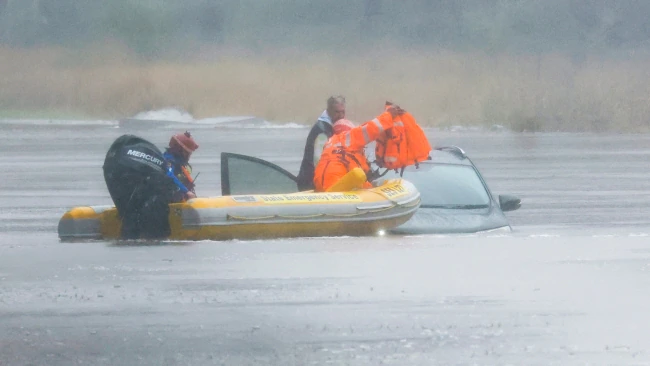Flood disaster recovery payments in New South Wales, How To Claim.
Australia: Disaster funding has been approved for thousands of flood-affected residents in Sydney and its outskirts as severe storms and heavy rain continues to batter the state.
A natural disaster declaration for 23 local government areas (LGAs) was announced on Monday night amid the ongoing wild weather, which began on June 27.
Federal Emergency Minister Murray Watt said the government had approved a range of payments overnight in response to widespread floods and would consider providing future assistance “down the track” if required.
“Late last night, we reached an agreement with the NSW Government to activate a whole range of disaster-related payments under the disaster recovery funding arrangements,” he told reporters on Tuesday.
“That included support for individuals and families to low-interest loans for farmers, for small businesses, support for councils.”
Which LGA’s are covered by the disaster funding?
The areas include Blacktown, Blue Mountains, Camden, Canterbury Bankstown, Campbelltown, Central Coast, Cessnock, Fairfield, Georges River, Hawkesbury, Hornsby, Kiama, Lithgow, Northern Beaches, Penrith, Shellharbour, Shoalhaven, Sutherland, The Hills, Wingecarribee, Wollondilly, and Wollongong.
What are the eligibility criteria for flood disaster recovery payments?
A lump-sum payment of $1,000 per adult and $400 per eligible child is available to residents living in one of the listed LGA’s severely affected by the floods.
You are eligible for the payment if you were injured due to the floods.
You can also claim if you are the immediate family member of a person who has died or gone missing in the floods.
If your home or significant asset at your home (cars, caravans, machinery) suffered substantial damage as a result of the floods.
Prime Minister Anthony Albanese is set to visit flood-impacted areas of Sydney on Wednesday, says Sky News Political Editor Andrew Clennell. “My heart goes out to people who’ve suffered again and again,” Mr. Albanese said on Tuesday. NSW…
How badly damaged does my home need to be?
A home or major asset at your home must suffer significant damage to be eligible for a disaster recovery payment.
Significant damage includes if the home is destroyed or must be demolished, has been declared structurally unsound, or if the home’s interior is exposed to external elements and sewage.
The payment also covers items inside the home that may need replacing due to damage, including flooring or furnishing, electrical items, and the home’s metal structures.
You are not eligible to claim if your home has experienced minor water damage.
A man is rescued from his car by State Emergency Service workers in Windsor on July 04, 2022, in Sydney, Australia. Photo by Jenny Evans/Getty Images.

Flood disaster recovery payments
Who can apply for the flood recovery payment?
You can claim the payment on behalf of a dependent child you’re a principal carer.
If you’re a couple affected by the floods, you are both eligible for the payment but will need to make separate claims.
A person cannot claim the payment on behalf of someone who has died or their estate.
What are other flood disaster payments available?
The Disaster Recovery Allowance provides short-term assistance for those unable to work due to the floods.
Residents living in flood-affected LGA’s can claim the allowance depending on if they meet specific criteria.
From the date you start losing income, you can get a weekly payment of $350 for up to 13 weeks.
People already receiving government payments such as the pension, JobSeeker, ABSTUDY, or Parental Leave Pay are not eligible.
What are the eligibility criteria for flood disaster recovery payments?
A lump-sum payment of $1,000 per adult and $400 per eligible child is available to residents living in one of the listed LGA’s severely affected by the floods.
You are eligible for the payment if you were injured due to the floods.
You can also claim if you are the immediate family member of a person who has died or gone missing in the floods.
If your home or significant asset at your home (cars, caravans, machinery) suffered major damage as a result of the floods.
How badly damaged does my home need to be?
A home or major asset at your home must suffer major damage to be eligible for a disaster recovery payment.
Major damage includes if the home is destroyed or must be demolished, has been declared structurally unsound, or if the home’s interior is exposed to external elements and sewage.
The payment also covers items inside the home that may need replacing due to damage, including flooring or furnishing, electrical items, and the home’s metal structures.
You are not eligible to claim if your home has experienced minor water damage.
Who can apply for the flood recovery payment?
You can claim the payment on behalf of a dependent child you’re a principal carer.
If you’re a couple affected by the floods, you are both eligible for the payment but will need to make separate claims.
A person cannot claim the payment on behalf of someone who has died or their estate.
What are other flood disaster payments available?
The Disaster Recovery Allowance provides short-term assistance for those unable to work due to the floods.
Residents living in flood-affected LGA’s can claim the allowance depending on if they meet specific criteria.
From the date you start losing income, you can get a weekly payment of $350 for up to 13 weeks.
People already receiving government payments such as the pension, JobSeeker, ABSTUDY, or Parental Leave Pay are not eligible.
The federal government has also announced additional support for families accessing early childhood education and care services.
The additional support means services can waiver gap fees for children unable to attend care due to floods and other paid leave for families, so they don’t use up their annual allocation.
The measures were implemented to help provide relief for families and keep children enrolled in childcare during a natural disaster.
For information on personal hardship and distress assistance, contact Service NSW on 13 77 88.
To apply for a concessional loan or primary producer grant, contact the NSW Rural Assistance Authority on 1800 678 593 or visit www.raa.nsw.gov.au.
Information on disaster assistance can be found on the National Recovery and Resilience Agency’s website at www.recovery.gov.au.
Also Read
Bowel cancer symptoms searches rose after Deborah James’s death
Several across Australia demonstrated in solidarity with the US after the abortion access ruling
Google will delete the location history for visits to abortion clinics
More Than a 30% rise has been seen in the United Kingdom Covid Cases
Follow us or bookmark us for more News Celeb Bio box office collection report celebrities trailers and promos
Join us on Facebook
Join us on Twitter

